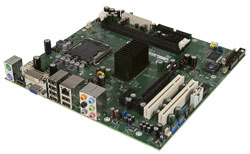Thoughts
It's been a long time coming since CeBIT, and we now expect MCP78 and MCP79 (sporting DX10 IGPs) to be pushed back until Q1 2008, but MCP73 is finally here. The IGP performance in all cases is stated by NVIDIA to be enough to get Vista Premium certification, even at 500MHz IGP clock with one channel of memory (so just a 64-bit memory bus at 667MHz will do), and NVIDIA claim significantly better performance than any competing Intel IGP.
The reviewers guide material compares a 7050 configuration (500MHz IGP) to Intel GMA X3000 in a number of titles and apps under Vista, including the Sims 2, SimCity 4, Railroads!, Google Earth and Adobe Acrobat Reader 8 (which features GPU acceleration), and performance is improved (sometimes significantly according to NVIDIA) over the GMA X3000 in all cases. In some cases the comparisons include enabling image quality options the GMA X3000 simply can't in some titles, indicating DX9 capability support is higher than Intel can muster with their top-end IGP.
While the 3D performance isn't going to win any awards, it's reasonable to say, without testing, that MCP73 is likely to hold the overall Intel IGP performance crown (in all configurations). However, Intel's X3000 raw specifications are superior in certain ways (including the number of TMUs), so they might still certainly win a number of benchmarks when their drivers behave and their hardware is efficient enough.
Mainboards implementing MCP73 are likely to follow the basics of the design above. Almost all (if not all) designs will sport the PCIe x16 slot, at least on x1 slot as pictures, the single memory channel via two DIMM slots, passive cooling for the MCP73 die and at least one digital output. You can see the mainboard above sports the HDMI output too, present on the upper two models sporting GeForce 7100 and GeForce 7150 in their name.
MCP73 is being quietly launched into retail and the channel, with system builders and OEMs likely to integrate mainboards sporting the IC into designs ready for the Christmas season. They've missed the back-to-school end of summer rush, which pretty confirms that the chip was broken in a significant enough way earlier in the year to force a respin and delay for a quarter or two.
We look forward to getting out hands on a board for some testing versus current Intel IGPs.


